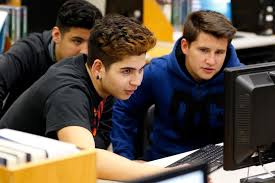 STREAMWOOD, Ill.: It’s a small generator that could power a small light, but the invention could pay some big dividends for a group of Streamwood High School students.
STREAMWOOD, Ill.: It’s a small generator that could power a small light, but the invention could pay some big dividends for a group of Streamwood High School students.
Their wind-powered generator idea won the state competition in the Samsung Solve for Tomorrow contest, which encourages teachers and students to solve real-world issues using classroom skills in science, technology, engineering, arts and mathematics. The 16 students will compete this spring for 10 national finalist slots and ultimately a prize of up to $200,000.
The generator, which students started building earlier this year, will stand about 2 feet tall and could power a safety light – an economical way of illuminating poorly lit neighborhoods or public spaces, such as parks and parking lots.
“It’s like a real-life experience,” said senior Andrea Greter, 17, of Streamwood. “We’re actually finding a problem and fixing it. We’re working to make something real. (Engineering) can solve so many problems.”
Matt Erbach, the students’ mentor and engineering class teacher, says their generator is a “microgeneration” project – the small-scale production of renewable heat and electric power.
“Essentially, we are using a tiny motor as a miniature energy generator,” said Erbach, who also teaches precision manufacturing. “We are using wind power to generate enough electricity to power a safety light, not something that is as bright as a street lamp, but something to make it more visible. Microgeneration isn’t really a big deal here, but in the developing world it is huge.”
Microgeneration can use solar, air source, ground source and biomass energy. It can be an alternative or supplement to traditional centralized power grids that people, small businesses and communities can implement to meet their own needs.
Erbach, a Rolling Meadows resident and a teacher in Elgin Area School District U-46 for 10 years, has entered the contest twice before with other sustainable ideas; he hopes this third attempt will take the school all the way to the top.
Erbach’s 2015 project to teach students about energy management and green housing while helping homeowners save on energy costs was named a state winner in the Samsung contest, but didn’t make the national finals. Still, it earned the school $25,000 in technology grants, which went to purchase Chromebooks, printers and cameras for several preschool programs within U-46.
This year, Streamwood again will receive another $25,000 in technology goodies, including a laptop to create a video showcasing how the generator can be used to benefit humanity.
“It’s tough to find a problem that the kids can actually get within striking distance of fixing,” Erbach said. “Anything that is environmentally positive is a good thing. When you are designing something as an engineer, you are designing typically to make things better.”
The nonprofit Tooling & Manufacturing Association Education Foundation is providing design and manufacturing support for this project.
Erbach said he looked into installing the lights powered by the students’ generator at homeless shelters and churches in poor neighborhoods, but the ones he approached were reluctant to participate.
“We are looking right now for more local (sites) that we can hit quickly so we can meet the time constraints of the program,” he said. “Our own parking lot in the school has some dark areas. The city of Elgin has community gardens that could benefit from a little bit of light at night. We want five sites to beta test. The kids are researching it right now.”
Erbach also would like students to work on a wind energy-powered mobile device charger, like a USB, that could power a phone or tablet device in places with no electricity. -AP






